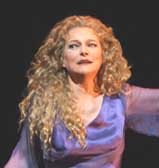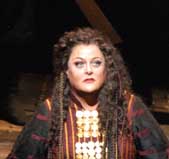Key Word Search
Multi-Field Search
Browse
Repertory Report
Performers Report
Contacts
Met Opera Website
New Production
Les Troyens
Metropolitan Opera House, Mon, February 10, 2003
Debut : Maria Bjørnson, Anita Yavich, Doug Varone, Kayvon Pourazar, Griff Braun
Les Troyens (29)
Hector Berlioz | Hector Berlioz
- Cassandra/Cassandra's Ghost
- Deborah Voigt
- Coroebus/Coroebus's Ghost
- Dwayne Croft
- Aeneas
- Ben Heppner
- Ascanius
- Jossie Pérez
- Priam/Priam's Ghost
- Julien Robbins
- Hecuba
- Jane Bunnell
- Helenus
- Ronald Naldi
- Andromache
- Alexandra Deshorties
- Astyanax
- Zarin Lal
- Panthus
- Tigran Martirossian
- Hector's Ghost
- Peter Volpe
- Trojan Soldier
- Brian Davis
- Anna
- Elena Zaremba
- Narbal
- Robert Lloyd
- Iopas
- Matthew Polenzani
- Mercury
- Morris Robinson
- Hylas
- Gregory Turay
- Trojan Soldier
- Patrick Carfizzi
- Trojan Soldier
- James Courtney
- Laocoön
- Kayvon Pourazar [Debut]
- Dance
- Kristen Hollinsworth
- Dance
- Peter Di Bonaventura
- Dance
- Desiree Sanchez Meineck
- Dance
- Griff Braun [Debut]
- Conductor
- James Levine
- Production
- Francesca Zambello
- Set Designer
- Maria Bjørnson [Debut]
- Costume Designer
- Anita Yavich [Debut]
- Lighting Designer
- James F. Ingalls
- Choreographer
- Doug Varone [Debut]
The Metropolitan Opera dedicates this performance to the memory of Maria Bjørnson whose untimely death deprived us of a beloved friend and colleague.
Production photos of Les Troyens, Parts I & II, by Marty Sohl / Metropolitan Opera:
FUNDING:
The production a gift of the estate of Francis Goelet, Mr. and Mrs. Ezra K. Zilkha, Mr. and Mrs. Sid R. Bass, Edgar Foster Daniels Foundation, Mr. and Mrs. William R. Miller, Mr. and Mrs. Paul M. Montrone.
Additional funding by The Annenberg Foundation, Gilbert S. Kahn and John J. Noffo Kahn, and the National Endowment for the Arts.
Review 1:
Review of David J. Baker in the May 2003 issue of OPERA NEWS
Francesca Zambello's epic "Les Troyens" seemed to stretch the dimensions of the Met stage in several directions.
To open the Berlioz bicentennial year, the Met called on one of the world's leading opera directors to stage a new production of "Les Troyens." Francesca Zambello's vertiginous track record, from Japan to London's West End, by way of most major Opera houses in between, and her mastery of epic scale (in such works as "Boris Godunov," "War and Peace" and "Billy Budd") have eclipsed the unpleasant memory of her controversial Met "Lucia di Lammermoor" (1992). The new "Troyens" which opened on February 10, found her in the grandiose rather than radical vein, expanding the dimensions of the Met stage in several directions.
Memories of her coffin-strewn "Lucia" surface briefly in the Act I ensemble following the news of the massacre of Laocoön and his sons. Here the Trojans come to grips with their horror - and literally with the three victims, as dancers bodysurf over the chorus.
This detail flows from one of Zambello's apparent ambitions: to reinvent the crowd scene as we know it. This means interaction with the soloists and among chorus members, who often get pressed into close formation. The [beginning] curtain finds the Trojans intertwined as if in a mass grave, or possibly a group nap, from which they proceed to disentangle themselves. Too often, the heavy foot traffic seems unmotivated, an impediment to dramatic focus - especially at climactic moments such as Enée's urgent first entrance, the vision of Hector or Cassandre's distraught reactions to the procession of the giant horse. In the rapt love duet, Didon and Enée weave through a mob of embracing couples, just when the music emphasizes their total isolation.
Another Zambello preoccupation is a seamless, cinematic overlapping between acts. (Here, the five are treated as three.) This can result in liberties with the libretto (such as the quickie pantomimes during the "Royal Hunt and Storm" interlude and
after the love duet), as well as excessive underlining of points. Young Ascagne's conversion into a randy Cherubino seems gratuitous. The most egregious elbow-in-the-ribs moment is the trivializing pantomime performed by the outraged Tyrians at the final curtain, as they gesture rudely with the Trojans' gifts. In its broad outlines, though, this is a workable, suitably grandiose mounting of an important opera, a staging that tries to retrofit some of the lopsided dramatic dimensions. Awkwardly or not, connections are established across the five-hour evening. The director integrates all resources into a general sense of historic mission and moral struggle. The late Maria Bjornson's sets provide an architectural framework that starts as a constellation of abstract shards (read: disintegration) and ends Acts II and V by suggesting the roof of Rome's Pantheon. The backdrop in Carthage hints at blue sky and golden wheat, which soon lose their pristine, primary hues.
Costumes by Anita Yavich, attractive and less elaborate than the layered Minoan finery of the Met's previous "Troyens," make the Trojans look medieval, and drape the Carthaginians in timeless white. Doug Varone's choreography, zestfully performed, helps avoid the longueurs that plague some productions in the Act IV dance sequence.
Zambello directed the singers effectively. Deborah Voigt brought Cassandra's big gestures of frustration to searing vocal life but rarely suggested the character's vision and inner torment. The converse could be said of the affecting Didon of Lorraine Hunt Lieberson. The mezzo's sensitive phrasing and vocal coloring - not to mention her magnificent way with the French text - took us to the heart of Didon's character. Hunt Lieberson needed only a bit more volume to extend the scale of her portrayal in scenes such as her cursing of the departing hero. Not even a vocal accident or two could mar Ben Heppner's resplendent performance as Enée. His progress since recording the role (LSO 0010] included an unexpected sensitivity in some of the lyric phrases that we thought had been retired with Jon Vickers.
Dwayne Croft (Chorébe), Matthew Polenzani (Iopas) and Gregory Turay (Hylas) sang their lyrical music warmly. Assigning the gruffer timbres of Elena Zaremba to the florid role of Anna and Robert Lloyd to that of Narbal proved less effective.
Levine's orchestra and chorus usually hit the mark in the spine-tingling ensembles that any "Troyens" needs, and the conductor was his most persuasive in the flexible lilt of the love duet. Still, given his experience and affinity for the score, the results might have been more consistent. Some of the women's chorus in Act II as well as the ceremonial music in Didon's last scenes, seemed wooden. To restore the Act I finale to its intended grandeur, the chorus should be put back in its place - where it can't drown out Cassandre and the orchestra.
Search by season: 2002-03
Search by title: Les Troyens,
Met careers
- James Levine [Conductor]
- Deborah Voigt [Cassandra/Cassandra's Ghost]
- Dwayne Croft [Coroebus/Coroebus's Ghost]
- Ben Heppner [Aeneas]
- Jossie Pérez [Ascanius]
- Julien Robbins [Priam/Priam's Ghost]
- Jane Bunnell [Hecuba]
- Ronald Naldi [Helenus]
- Alexandra Deshorties [Andromache]
- Zarin Lal [Astyanax]
- Tigran Martirossian [Panthus]
- Peter Volpe [Hector's Ghost]
- Brian Davis [Trojan Soldier]
- Lorraine Hunt Lieberson [Dido]
- Elena Zaremba [Anna]
- Robert Lloyd [Narbal]
- Matthew Polenzani [Iopas]
- Morris Robinson [Mercury]
- Gregory Turay [Hylas]
- Patrick Carfizzi [Trojan Soldier]
- James Courtney [Trojan Soldier]
- Francesca Zambello [Production]
- Maria Bjørnson [Set Designer]
- Anita Yavich [Costume Designer]
- James F. Ingalls [Lighting Designer]
- Doug Varone [Choreographer]
- Kayvon Pourazar [Laocoön]
- Kristen Hollinsworth [Dance]
- Peter Di Bonaventura [Dance]
- Desiree Sanchez Meineck [Dance]
- Griff Braun [Dance]

